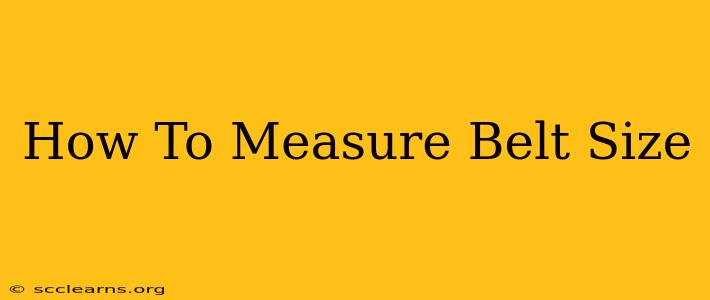Finding the perfect belt can be surprisingly tricky. Knowing your belt size isn't just about picking a number; it's about ensuring a comfortable and stylish fit. This comprehensive guide will walk you through how to accurately measure your belt size, regardless of whether you're buying a new belt or replacing an old one. We'll cover everything from measuring your waist to understanding different belt sizing systems.
Understanding Belt Sizing: More Than Just Inches
Before we dive into the measurement process, it's crucial to understand that belt sizing is not a direct measurement of your waist. Belt size refers to the length of the belt, measured from the buckle end to the center hole. Your waist size is simply a starting point to help you determine the appropriate belt length.
Many people mistakenly believe their pant size is their belt size. This isn't always the case. Pants sizes are typically measured differently than belts.
Method 1: Measuring Your Existing Belt (The Easiest Way)
This is the simplest method if you already own a belt that fits you well.
- Lay it flat: Lay your well-fitting belt flat on a ruler or measuring tape.
- Measure from buckle to center hole: Measure the distance from the inside edge of the buckle to the center hole. This measurement represents your belt size.
- Note the material: Take note of the material, as different materials can stretch or shrink slightly.
Method 2: Measuring Your Waist (For Buying a New Belt)
If you're buying a new belt and don't have a well-fitting one to use as a reference, you'll need to measure your waist.
- Find your pants size: Locate a pair of pants that fit you comfortably at the waist.
- Measure the waistband: Lay the pants flat and measure the inside circumference of the waistband. This measurement will be your starting point.
- Add extra length: Add approximately 1 to 2 inches to account for the buckle and desired overlap. This addition depends on your preferred fit. A shorter overlap means a tighter fit, while a longer overlap offers more room for adjustment.
- Consider belt material: Keep in mind that some belt materials (like leather) stretch over time, so you might want to account for that as well.
Method 3: Using a Measuring Tape Directly on Your Waist
While less precise than using an existing belt, you can also directly measure your waist.
- Find your natural waist: This is the narrowest part of your waist, usually above your belly button.
- Measure your circumference: Wrap a measuring tape around your waist at your natural waistline. Make sure the tape is snug but not too tight.
- Add extra length: Add approximately 1-2 inches to the waist measurement, depending on your preferred overlap.
Different Belt Sizing Systems and Considerations
It's important to note that belt sizing isn't standardized across all brands. Some brands use even numbers, while others use odd numbers. Always check the specific sizing chart provided by the retailer or manufacturer.
Key Considerations:
- Belt material: Leather belts can stretch over time, while others might not.
- Intended use: A dress belt will likely have a different desired overlap than a casual belt.
- Personal preference: Some people prefer a tighter fit, while others prefer a looser fit.
Troubleshooting Common Belt Size Issues
- Belt too tight: If your belt feels too tight, even after adjusting holes, you might need a larger size.
- Belt too loose: If the belt feels too loose, consider tightening the belt or trying a smaller size.
By following these methods and understanding the nuances of belt sizing, you can confidently choose the perfect belt that fits your style and needs. Remember to always double-check the manufacturer's sizing chart for the most accurate results. Happy belting!

